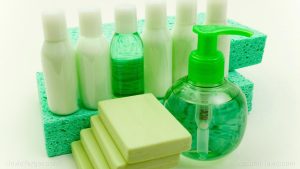
Lanolin – toxicity, side effects, diseases and environmental impacts
Wednesday, November 29, 2017 by Zoey Sky
http://www.naturalpedia.com/lanolin-toxicity-side-effects-diseases-and-environmental-impacts.html

Lanolin is a natural, waxy substance found in sheep’s wool, and it is made with manufacturing processes that reduce certain allergens in the lanolin. Lanolin topical (for the skin) is used to treat or prevent dry skin, itching or other skin irritation caused by conditions such as diaper rash, radiation therapy skin burns, and others. Lanolin topical is also used to treat sore and cracked nipples caused by breast-feeding.
Lanolin keeps the fur moist and protects sheep skin. Once a sheep has been shorn, a waxy substance called sebum is left on the fur. Sebum comes from the animal’s sebaceous glands, the same way human skin produces oil, and is affected by hormone production.
While lanolin contains sebum, it can also contain sweat, dirt, dust, pollen, fecal matter, and other contaminants. Different sheep breeds also create different consistencies of lanolin with different makeups.
Lanolin must first be purified before it is used in any products, and the refining process, the chemicals used, and the degree of purity in the process varies per company. After refinement, lanolin is used in various skin care and beauty products for consumers and hospitals.

List of known side effects
Lanolin is classified as “not expected to be potentially toxic or harmful” and a “low human health priority” on the Environment Canada Domestic Substance List.
Livestock owners often “dip” sheep into insecticides because they are susceptible to pests. The pesticide residue in lanolin presented two specific dangers: some of the pesticides could accumulate in fat tissue, and it could accumulate in the milk of breastfeeding women.
Wool alcohol, a component of lanolin, is the main source of allergens connected with this substance. People exposed to wool alcohol may develop allergic contact dermatitis, a type of rash, when they use products with lanolin.
Body systems affected by lanolin
Swallowing products that contain lanolin can cause poisoning. Signs of lanolin poisoning include diarrhea, vomiting, rash, skin redness, and swelling.
Items that can contain lanolin
Lanolin is commonly used in cosmetics, toiletries, and medicines. Avoid products that list any of the following names in the ingredients:
- Wool alcohols (lanolin) or anhydrous lanolin
- Wool Fat or Grease
- Wool Wax
- Wool Grease Fatty Acid
- Wool Fats and Glyceridic Oils
- Fats
- Lanolin
- Adeps Lanae
- Degras
Here are some products that may contain lanolin:
- Baby oils
- Hemorrhoid preparations
- Household polishes and waxes
- Impregnating agents for textile, leather goods and furs
- Insulation for wiring
- Metal-working fluids – Corrosion inhibitors, cutting fluids, and lubricants
- Over-the-counter and prescription treatments for skin rashes or dermatitis
- Personal care products – Cosmetics (foundations, powders, blush, mascaras, eyeshadows, eyeliners, and eye pencils), hair sprays, hair removers and shaving products, lipsticks and lip balms, nail enamel remover, personal hygiene products (soaps, cleansers, and shampoos), and skin care products (hand lotions, balms, creams, facial masks, ointments, lotions and moisturizers)
- Pet care or veterinary products – Pet shampoos, conditioners and grooming aids
- Polishes and waxes
- Printing inks
- Shoe polishes
- Sunscreens
How to avoid lanolin
Avoid lanolin by not using the products listed above. Some people are exposed to products that contain lanolin more than others, such as:
- Nurses
- Janitors
- Hairdressers and cosmetologists
- Mechanics
- Electricians
- Machinists
- Machine operators
- Assemblers
- Construction workers
Where to learn more
- Newborn Baby Essentials that Every Mother Must Insist On
- Natural Sunburn Remedies Help Relieve Pain and Heal Your Skin
- Five ways to get more vitamin D through natural sources
- 15 Petrochemical Skin Care Ingredient to Avoid
- Beat Big Pharma drug prices and chemical additives – Make your own safe, high quality, natural topical ointments at home
Summary
Lanolin is a natural, waxy substance found in sheep’s wool.
Once refined, lanolin is used in different skin care and beauty products.
Swallowing products that contain lanolin can cause poisoning. Symptoms of lanolin poisoning include diarrhea, vomiting, rash, skin redness, and swelling.
Sources include:
Tagged Under: Tags: lanolin





